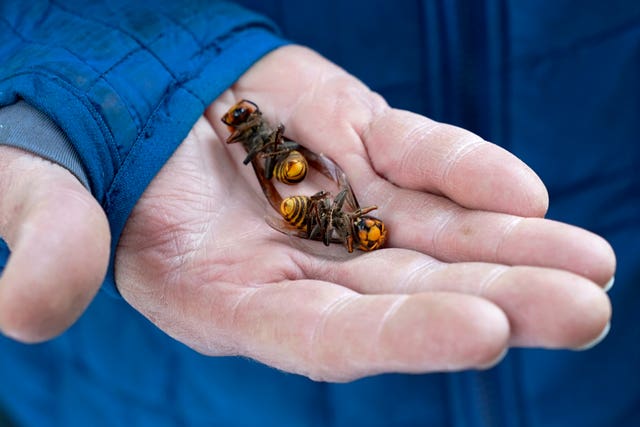Invasive giant hornet which can wipe out beehives declared eradicated in US
The northern giant hornet was first spotted five years ago but there have been no further sightings since 2021.

The world’s largest hornet, an invasive breed dubbed the “murder hornet” for its dangerous sting and ability to slaughter a honey beehive in a matter of hours, has been declared eradicated in the US.
The giant insect was first spotted five years ago in Washington state near the Canadian border.
The Washington and US departments of agriculture announced the eradication on Wednesday, saying there had been no detections of the northern giant hornet in Washington since 2021.
The news represented an enormous success that included residents agreeing to place traps on their properties and reporting sightings, as well as researchers capturing a live hornet, attaching a tiny radio tracking tag to it with dental floss, and following it through a forest to a nest in an alder tree.

“I’ve gotta tell you, as an entomologist – I’ve been doing this for over 25 years now, and it is a rare day when the humans actually get to win one against the insects,” Sven Spichiger, pest programme manager of the Washington State department of agriculture, told a virtual news conference.
The hornets, which can be 2in long and were formerly called Asian giant hornets, gained attention in 2013, when they killed 42 people in China and seriously injured 1,675.
In the US, about 72 people a year die from bee and hornet stings each year, according to data from the National Institutes of Health.
The hornets were first detected in North America in British Columbia, Canada, in August 2019 and confirmed in Washington state in December 2019, when a Whatcom County resident reported a specimen.
A beekeeper also reported hives being attacked and turned over specimens in the summer of 2020. The hornets could have travelled to North America in plant pots or shipping containers, experts said.
DNA evidence suggested the populations found in British Columbia and Washington were not related and appeared to originate from different countries.
There also have been no confirmed reports in British Columbia since 2021, and the non-profit Invasive Species Centre in Canada has said the hornet is also considered eradicated there.
Northern giant hornets pose significant threats to pollinators and native insects.
They can wipe out a honey beehive in as little as 90 minutes, decapitating the bees and then defending the hive as their own, taking the brood to feed their own young.
The hornet can sting through most beekeeper suits, deliver nearly seven times the amount of venom as a honey bee, and sting multiple times. At one point, the Washington agriculture department ordered special reinforced suits from China.
Washington is the only state that has had confirmed reports of northern giant hornets. Trappers found four nests in 2020 and 2021.
Mr Spichiger said Washington will remain on the lookout, despite reporting the eradication.
He noted that entomologists will continue to monitor traps in Kitsap County, where a resident reported an unconfirmed sighting in October but where trapping efforts and public outreach have come up empty.
He noted that other invasive hornets can also pose problems: officials in Georgia and South Carolina are fighting yellow-legged hornets, and southern giant hornets were recently detected in Spain.
“We will continue to be vigilant,” Mr Spichiger said.





